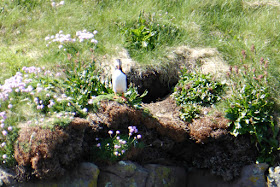But then, the Scottish government is committed to renewable energy, largely wind power.
The roads grew narrower and narrower as we drew further away from Lochinver. Finally we were on a single-track path with frequent pullouts, called "passing places," and Jim maneuvered amongst them with great skill. Parking at the seasonal ferry was another challenge met. This photo shows the ferry dock, and Handa is the wide island in the background. The tide had left much of the jetty underwater.
Our vessel was a semi-inflatable craft with room for twelve to fourteen people, comfortable enough for the short ride over. We climbed up the sandy dunes at the beach and arrived at the wardens and volunteers hut, and received an orientation briefing about what to do and not do. (You can also buy plush puffins and other knickknacks.)
Handa is owned by the Scourie Estate, primarily meaning Dr. Jean Balfour, but administered by the Scottish Wildlife Trust.
We set out in a counter-clockwise direction towards The Stacks on the north side.
We quickly came across a great skua, colloquially known as a bonxie, and then another and another.
 |
| They also flew by often. |
We also spotted blooming butterwort, a "carnivorous" plant that uses sticky leaves to trap and digest insects as a supplement to its diet in poor soils. Some types prefer alkaline, others acidic soils.
Our group soon approached the ruins of crofters' houses.
Life on Handa was hard enough, but when the potato blight hit in the mid-18th Century, all the inhabitants emigrated to Canada. Here's a closer look at the stonework.
 |
| Of stones they had plenty. Soil not so much. |
We reached the rugged northern side of the island with its sea stacks, rock formations formed by the assaults of the North Atlantic.
Jonathan warned us not to creep too close to the edge.
Looking back the way we had come so far.
Any crevice or hollow in the cliffs was an opportunity for nesting seabirds.
A closeup.
On these cliffs the birds are safe from most predators, but the wardens and volunteers are monitoring a small rat population closely. According to this newsletter (a pdf), brown rats were extirpated from Handa in 1997 but fifteen years later they were back.
On these cliffs the birds are safe from most predators, but the wardens and volunteers are monitoring a small rat population closely. According to this newsletter (a pdf), brown rats were extirpated from Handa in 1997 but fifteen years later they were back.
We staked out a lovely site for lunch and birdwatching.
We were all eager to see some of the charismatic puffins. It would be a pity to come to this island without binoculars.
They prefer burrows in the ground. Here's a
closeup, such as my camera could produce. Candace Andrews has pro level images here.
Even on a calm day the swells continued to batter away at the island.
As we continued counterclockwise we met Martin, a volunteer making stone steps on the heavily traveled trail, and marveled at his dedication and hard work.
A double rent in the island.
A double rent in the island.
We lost what little altitude we'd gained as we approached the south side of the island, where various beaches lay.
Once back at the warden's hut there was time to explore the beaches, because other groups were ahead of us waiting for the ferry that constantly shuttled back and forth.
Our group returned in good cheer to the mainland, having enjoyed what Jonathan called the warmest and calmest day he'd ever experienced at Handa. The tide had fallen and left us a walk up the jetty. Jim pulled more drinks and biscuits/cookies out of our van, freshening us up for the return single-track ride.
We had a mandatory photo stop for Highland cows. These cattle are endowed with a double layer of hair, helping them survive the Scottish winter and giving them a unique appearance. One of our number, Nadia, is a big fan of the "highland coo," as it's pronounced, and this was an opportunity we couldn't pass up. Click on the image to enlarge.
 |
| Nice horns. |
This was the landscape in which our coo was spotted. The fences demarcating the fields are made of stone.
 |
| If good fences make good neighbors, these should be great! |
Then we were back at the Inver Lodge for dinner, and preparing to move on tomorrow to the Hebridean island of Lewis and Harris.




















No comments:
Post a Comment
Comments may not appear immediately as they are moderated by the author to eliminate spam. Please, no commercial links!